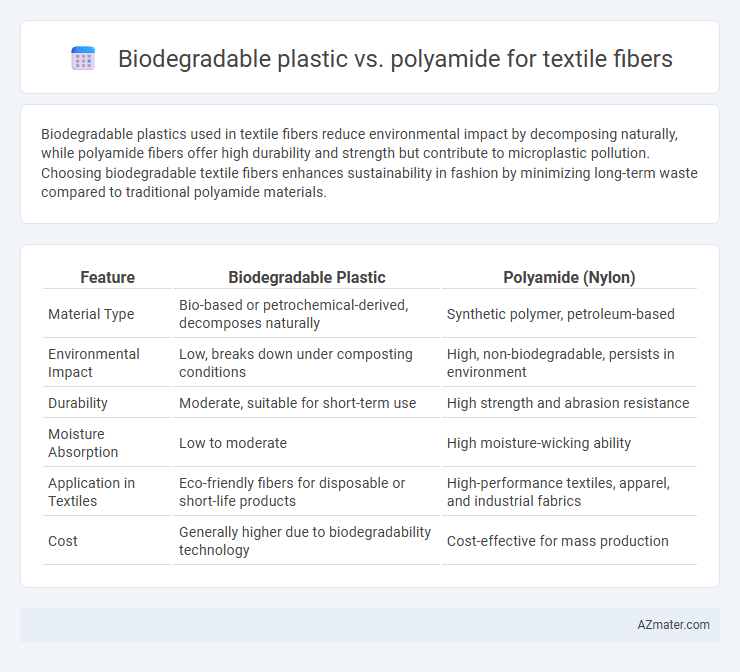Biodegradable plastics used in textile fibers reduce environmental impact by decomposing naturally, while polyamide fibers offer high durability and strength but contribute to microplastic pollution. Choosing biodegradable textile fibers enhances sustainability in fashion by minimizing long-term waste compared to traditional polyamide materials.
Table of Comparison
| Feature | Biodegradable Plastic | Polyamide (Nylon) |
|---|---|---|
| Material Type | Bio-based or petrochemical-derived, decomposes naturally | Synthetic polymer, petroleum-based |
| Environmental Impact | Low, breaks down under composting conditions | High, non-biodegradable, persists in environment |
| Durability | Moderate, suitable for short-term use | High strength and abrasion resistance |
| Moisture Absorption | Low to moderate | High moisture-wicking ability |
| Application in Textiles | Eco-friendly fibers for disposable or short-life products | High-performance textiles, apparel, and industrial fabrics |
| Cost | Generally higher due to biodegradability technology | Cost-effective for mass production |
Introduction to Textile Fibers: Biodegradable Plastics vs. Polyamide
Biodegradable plastics, derived from renewable resources like polylactic acid (PLA), offer eco-friendly alternatives to conventional textile fibers with reduced environmental impact through natural decomposition. Polyamide fibers, such as nylon, exhibit superior strength, elasticity, and durability but are petroleum-based and contribute to microplastic pollution. Comparing these fibers involves balancing renewable sourcing and biodegradability against performance characteristics critical for textile applications.
Material Composition and Source: Biodegradable Plastics and Polyamide
Biodegradable plastics in textile fibers are typically derived from renewable resources such as corn starch, cellulose, or polylactic acid (PLA), offering an eco-friendly alternative that decomposes naturally under composting conditions. Polyamide fibers, commonly known as nylon, are synthetic polymers produced through petrochemical processes involving the polymerization of diamines and dicarboxylic acids, resulting in a durable and high-performance material. The contrast in material composition highlights biodegradable plastics' reliance on bio-based polymers versus polyamide's fossil fuel-derived structure, impacting sustainability and environmental footprint in textile applications.
Environmental Impact and Sustainability Comparison
Biodegradable plastics in textile fibers significantly reduce environmental pollution through faster decomposition and lower carbon footprints compared to polyamide fibers, which rely on fossil fuels and release microplastics during washing. Polyamide production involves high energy consumption and emits greenhouse gases, while biodegradable alternatives utilize renewable resources and support circular economy models. Waste management improves with biodegradable fibers as they minimize landfill accumulation and pollutant leachates, enhancing sustainability in textile manufacturing.
Performance and Durability in Textile Applications
Biodegradable plastics in textile fibers offer eco-friendly advantages but generally exhibit lower durability and performance under mechanical stress and repeated washing compared to polyamide fibers. Polyamide, known for its exceptional strength, abrasion resistance, and elasticity, maintains dimensional stability and color retention over extended use, making it ideal for high-performance textile applications. While biodegradable fibers degrade faster under environmental conditions, polyamide ensures long-term durability and resilience, crucial for demanding apparel and technical textiles.
Biodegradability and End-of-Life Disposal
Biodegradable plastics for textile fibers decompose naturally through microbial activity, significantly reducing environmental impact by minimizing landfill accumulation and pollution. Polyamide fibers, typically non-biodegradable, persist in ecosystems for decades, contributing to microplastic pollution and challenging waste management efforts. End-of-life disposal for biodegradable fibers often involves composting or enzymatic degradation, whereas polyamide requires energy-intensive recycling or incineration, highlighting the sustainability advantages of biodegradable alternatives.
Manufacturing Process and Energy Consumption
Biodegradable plastics used in textile fibers often rely on renewable raw materials such as polylactic acid (PLA), produced through fermentation of biomass, which requires moderate energy inputs mainly in polymerization and fiber extrusion stages. Polyamide fibers, typically derived from petrochemicals, undergo energy-intensive processes including polymerization, spinning, and drawing, consuming significantly higher amounts of fossil fuel-based energy due to complex synthesis and drying techniques. Life cycle assessments reveal that biodegradable plastic fibers exhibit lower overall energy consumption during manufacturing compared to polyamide, contributing to reduced environmental impact in textile production.
Cost Analysis and Market Availability
Biodegradable plastics used in textile fibers generally incur higher production costs compared to polyamide due to raw material expenses and specialized processing requirements, impacting overall affordability. Polyamide fibers dominate the market with widespread availability, benefiting from established manufacturing infrastructure and lower price points, making them a cost-effective choice for large-scale textile production. Despite biodegradables gaining traction for sustainability, their limited supply chains and premium pricing hinder immediate widespread adoption in the textile industry.
Applications in Fashion and Technical Textiles
Biodegradable plastic fibers such as polylactic acid (PLA) offer sustainable alternatives in fashion applications by reducing environmental impact and enabling compostability while maintaining adequate strength and dyeability. Polyamide fibers, widely used in technical textiles, provide superior durability, elasticity, and resistance to abrasion and chemicals, making them ideal for performance wear and industrial uses. In comparing both, biodegradable plastics prioritize eco-friendly disposal in casual and mass-market fashion, whereas polyamides dominate technical textiles demanding high performance and longevity.
Consumer Perception and Industry Trends
Biodegradable plastics in textile fibers are gaining consumer favor due to their eco-friendly appeal and reduced environmental impact compared to traditional polyamide fibers, which face criticism for microplastic pollution. Industry trends reveal a growing investment in biodegradable alternatives as brands respond to increasing demand for sustainable materials, with innovations improving performance and cost-efficiency to rival polyamide properties. Market analysis indicates that consumer awareness and regulatory pressure are key drivers accelerating the shift towards biodegradable textile fibers within the fashion and technical textile sectors.
Future Prospects and Innovations in Textile Fibers
Biodegradable plastics such as polylactic acid (PLA) and polyhydroxyalkanoates (PHA) offer promising sustainable alternatives to conventional polyamide fibers, addressing environmental concerns through enhanced decomposition rates in natural conditions. Innovations in bio-based polymer blends and nanocomposite technologies aim to improve the mechanical strength, moisture management, and dyeability of biodegradable fibers, positioning them competitively against polyamides like nylon in textile applications. Future prospects include the integration of smart functionalities and circular economy principles, driven by advances in enzyme-based recycling and biosynthetic fiber production, marking a significant shift towards eco-friendly and high-performance textile materials.

Infographic: Biodegradable plastic vs Polyamide for Textile fiber
 azmater.com
azmater.com